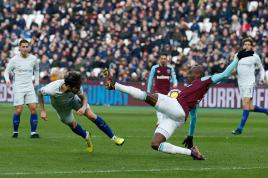Chelsea’s title race is already over, according to Antonio Conte after Chelsea’s surprise 1-0 defeat to West Ham United on Saturday afternoon. In fact, he continued, it never really started.
“This is the fourth defeat this season in 16 games,” said Conte. “When you have this start, it’s impossible to think you are in the title race. From experience, if you want to stay in the title race, in the first part of the season you can lose only once or twice.”
It was an understandable concession. Chelsea are 11 points behind Manchester City ahead of tomorrow’s Manchester derby, and more to the point, they’re not playing well enough to suggest they might overturn that deficit. But in truth, Chelsea’s season has been far from disastrous.
Amassing 32 points from 16 games is perfectly respectable: two-points-per-game is usually enough to keep a side in the title hunt at this stage of the season. Unfortunately for Conte and Chelsea, Manchester City have taken 43 points from 15 matches so far this season, a figure that, if sustained, would mean a record points haul in the Premier League. The competition at the top of the league this season is fierce, and Chelsea simply don’t quite have enough to properly compete.
The question, of course, is why.
Last season, Chelsea romped to the title with an incredible 93 points, but their problems this time around are basically threefold: there’s one physical issue and two tactical issues.
The physical issue is simple: Chelsea are exhausted. Upon taking charge last season, Conte surprised Chelsea’s players with the intensity of his physical exercises: he put his squad through lots of continuous sprinting drills, with the ball nowhere to be seen. It was, as John Terry said, the first time Chelsea had trained in that manner for more than a decade. The players felt physically sharp, however, and throughout last season when Chelsea had just one game a week, there were few signs of tiredness.
This time around, Chelsea have the complication of European football and were drawn in a difficult group featuring both Atletico and Roma, plus a ludicrously long trip to Qarabag. The effect has been considerable: often, Chelsea have simply lacked the energy and stamina to compete by the weekend. Conte has repeatedly complained about the limitations of his squad — mainly in the summer, in fairness — and almost any rotation has significantly weakened his starting XI.
Performances after Champions League matches have been particularly poor: two wins, two draws and two defeats, with one of those wins, against Watford, being entirely fortunate given that Chelsea were outplayed for long periods. This simply seems a side lacking sharpness, not helped by injuries to the likes of Victor Moses and Danny Drinkwater or by the fact Conte doesn’t remotely trust Michy Batshuayi, choosing to field a half-fit Alvaro Morata ahead of him here.
Then there are the two tactical issues. First, Chelsea’s brilliant 2016-17 campaign owed much to Conte’s decision to switch to a 3-4-3 formation in autumn. Chelsea won the next 13 games and were essentially out of sight by the turn of the year. It took opponents time to figure out how to play against Chelsea, but once they did, Chelsea went from keeping a clean sheet every week to conceding almost every week. Some of the performances in the second half of the season, particularly the 2-0 defeat at Old Trafford and the 2-1 FA Cup final loss to Arsenal, suggested that Chelsea’s system no longer caused such a surprise, in part because so many teams switched to 3-4-3 themselves.
Chelsea have lost that tactical trump card. In order to keep the opponent guessing, Conte has moved away from the 3-4-3 and has instead used a 3-5-2 for much of this season. For that he deserves great praise, but it’s also prompted a second problem: Conte can’t quite get the balance in midfield right.
The change in system was partly why Chelsea offloaded Nemanja Matic in order to bring in Tiemoue Bakayoko, more of a box-to-box player. But Bakayoko has been poor, underwhelming in possession and too often shirking his defensive responsibilities. The midfield trio has at least allowed Conte to make use of Cesc Fabregas’ midfield talents, but often he’s not collecting the ball in space.
Saturday’s defeat to West Ham was a good example: Fabregas played as one of the two advanced midfielders but with West Ham sitting deep, it was N’Golo Kante who received most space at the bottom of the trio. At times Conte has switched their roles to get Fabregas on the ball, but not here. Kante was afforded time on the ball but didn’t use it effectively enough. The midfield trio simply isn’t contributing enough in possession to compensate for the loss of Pedro Rodriguez, who provided an obvious attacking threat.
Chelsea’s season is far from over, of course, and Conte might well have considered this season’s priority the Champions League, a competition he simply didn’t crack during his three years with Juventus. Chelsea have struggled there so far: aside from routine wins over Qarabag, they earned just five points from four games against Atletico and Roma. But Conte remains a fine tactician and exactly the type of manager who should be suited to the knockout stage.
Coming second in their group means Chelsea are likely to be handed a tough draw in the next round, however. There are only three options: it could be Besiktas. More likely, it will be Barcelona or Bayern. Monday’s draw will be absolutely crucial in shaping the rest of Chelsea’s campaign.
It’s not quite a crisis for Chelsea: even if they finish fourth this season, Conte will have done a fantastic job over his first two seasons. Not many Chelsea managers, however, survive a season without the title, and it increasingly feels like this season might be Conte’s last in London.
Text credit: ESPN














